Submitted:
16 May 2023
Posted:
17 May 2023
You are already at the latest version
Abstract
Keywords:
1. Introduction
2. Materials and Methods
2.1. Sample Preparation Methodology
- Small fraction (devulcanized by grinding method) (size 0,1–2 mm);
- Large fraction (devulcanized by grinding method) (size 5–12 mm);
- Chemically devulcanized fraction (size 1–5 mm) (Figure 1).
2.2. Methodology of the Experimental Research of Transmission Loss in an Impedance Tube
2.3. Methodology of Predicting Transmission Loss According to Transfer Matrix Method (TMM)
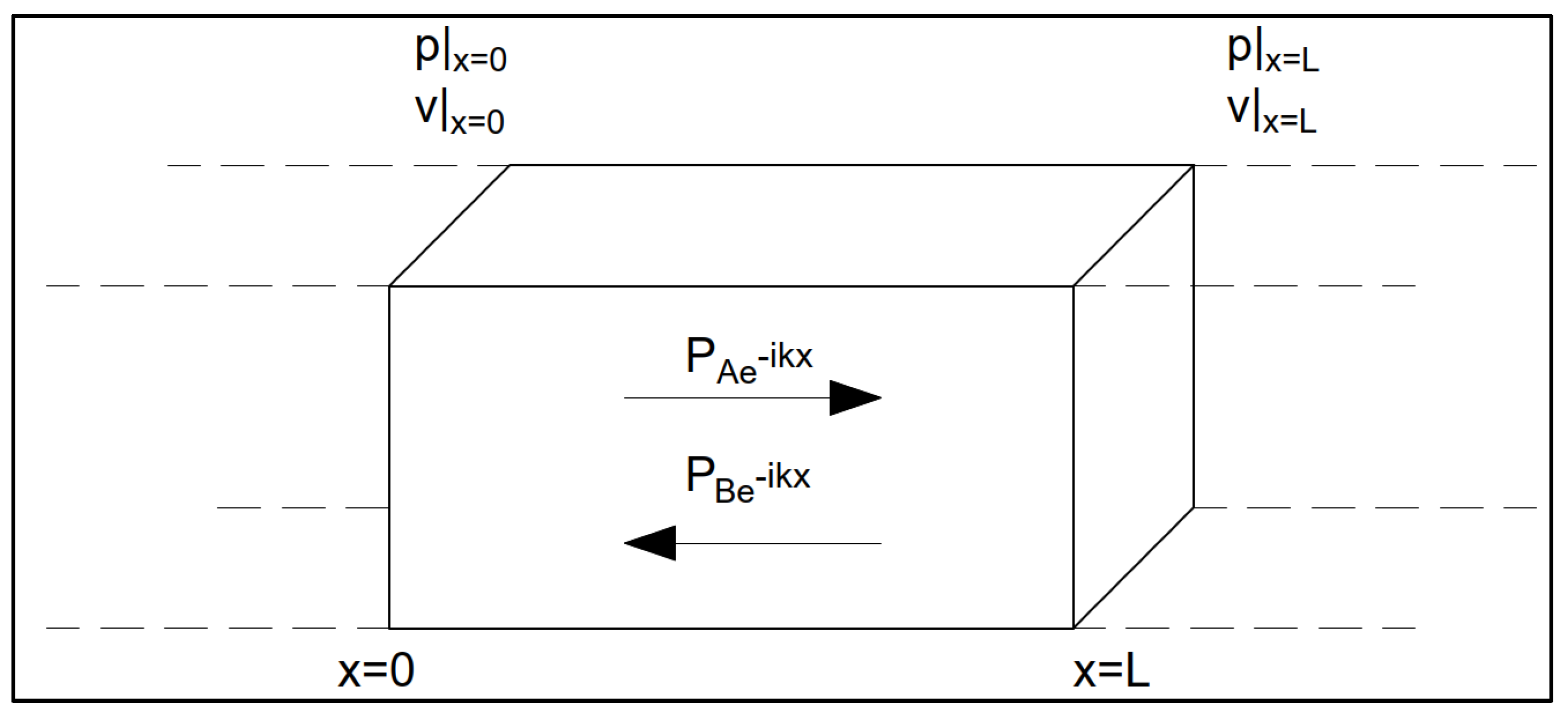
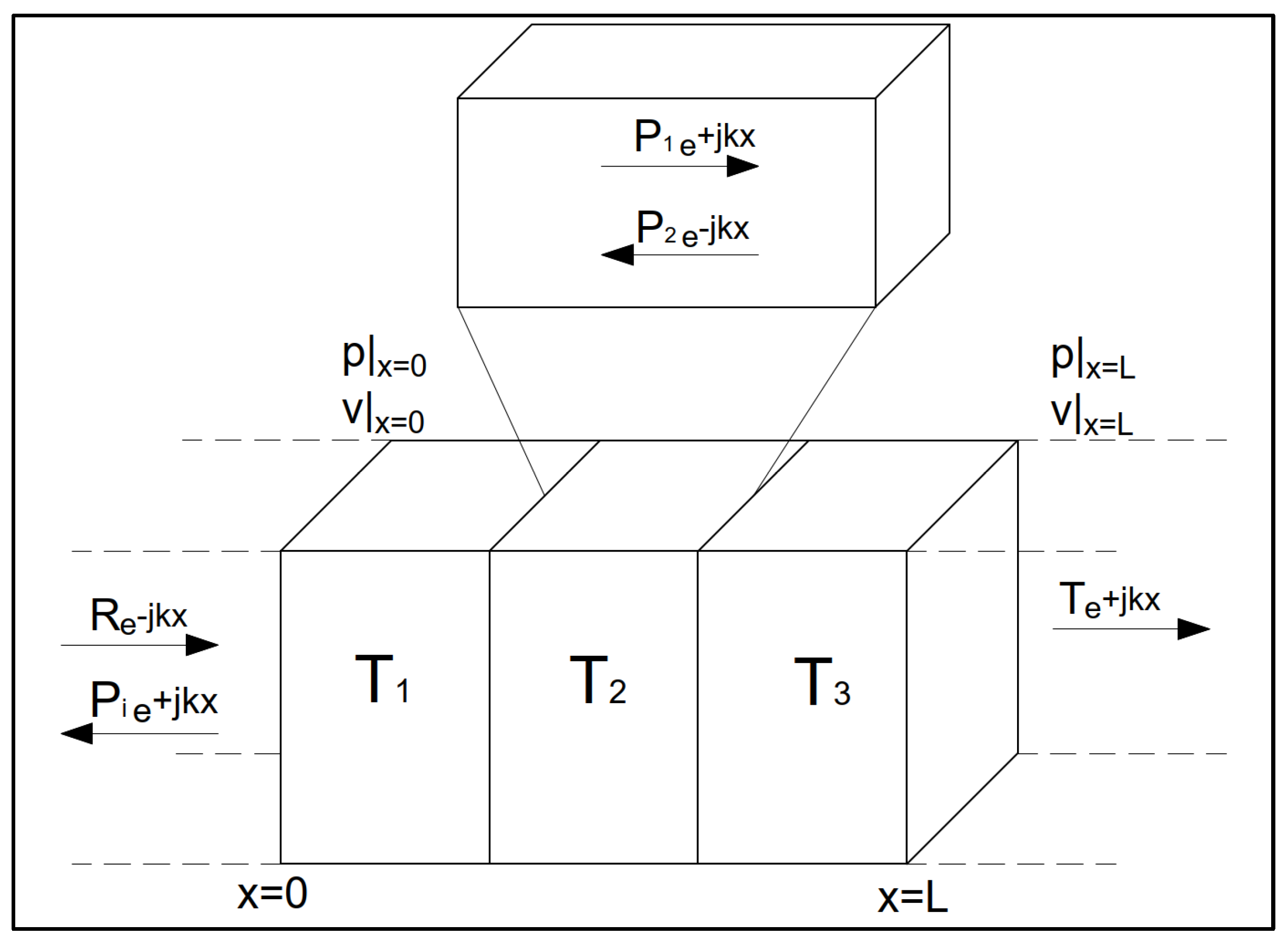
3. Results
3.1. Transmission Loss Results of TMM Analysis
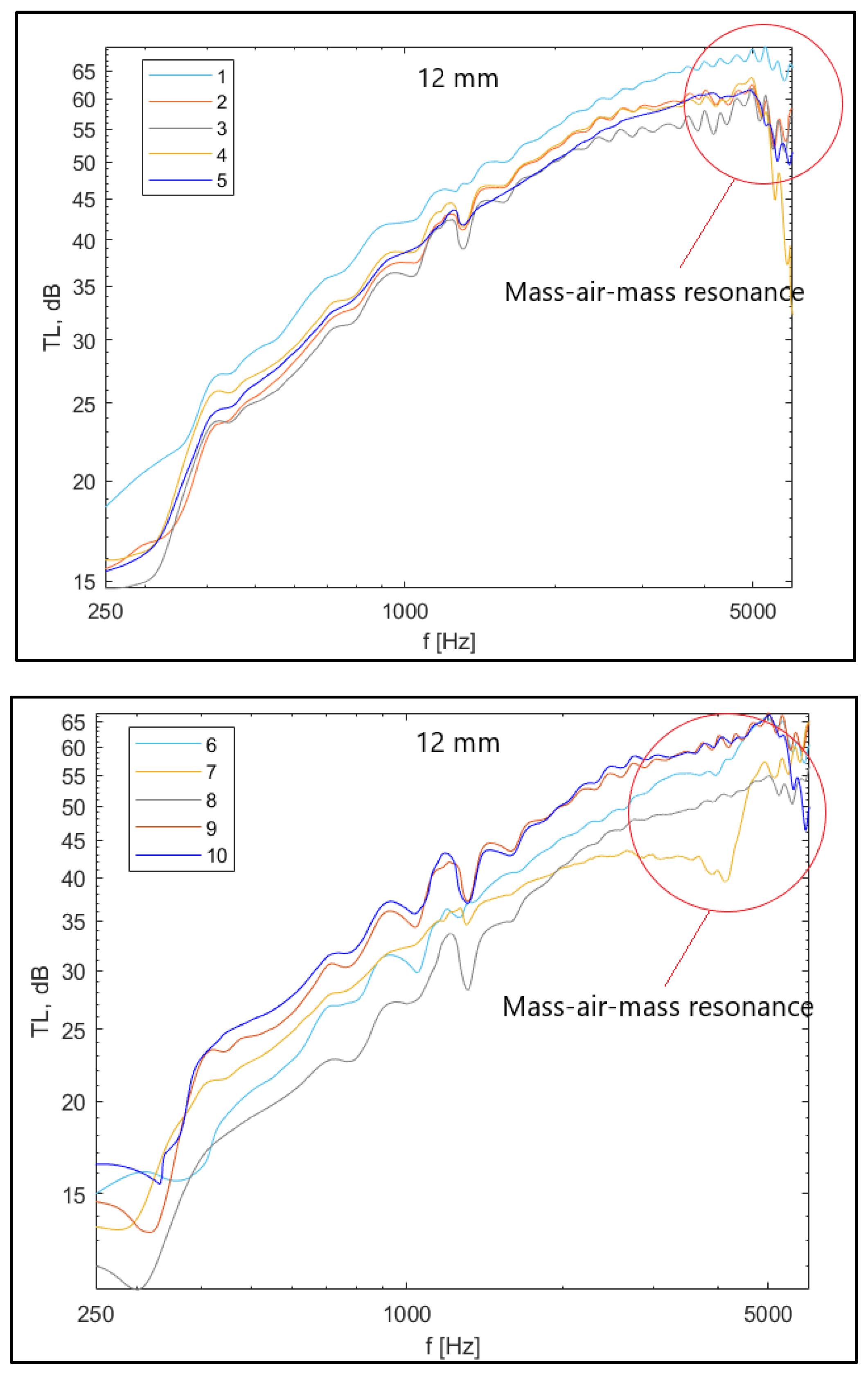
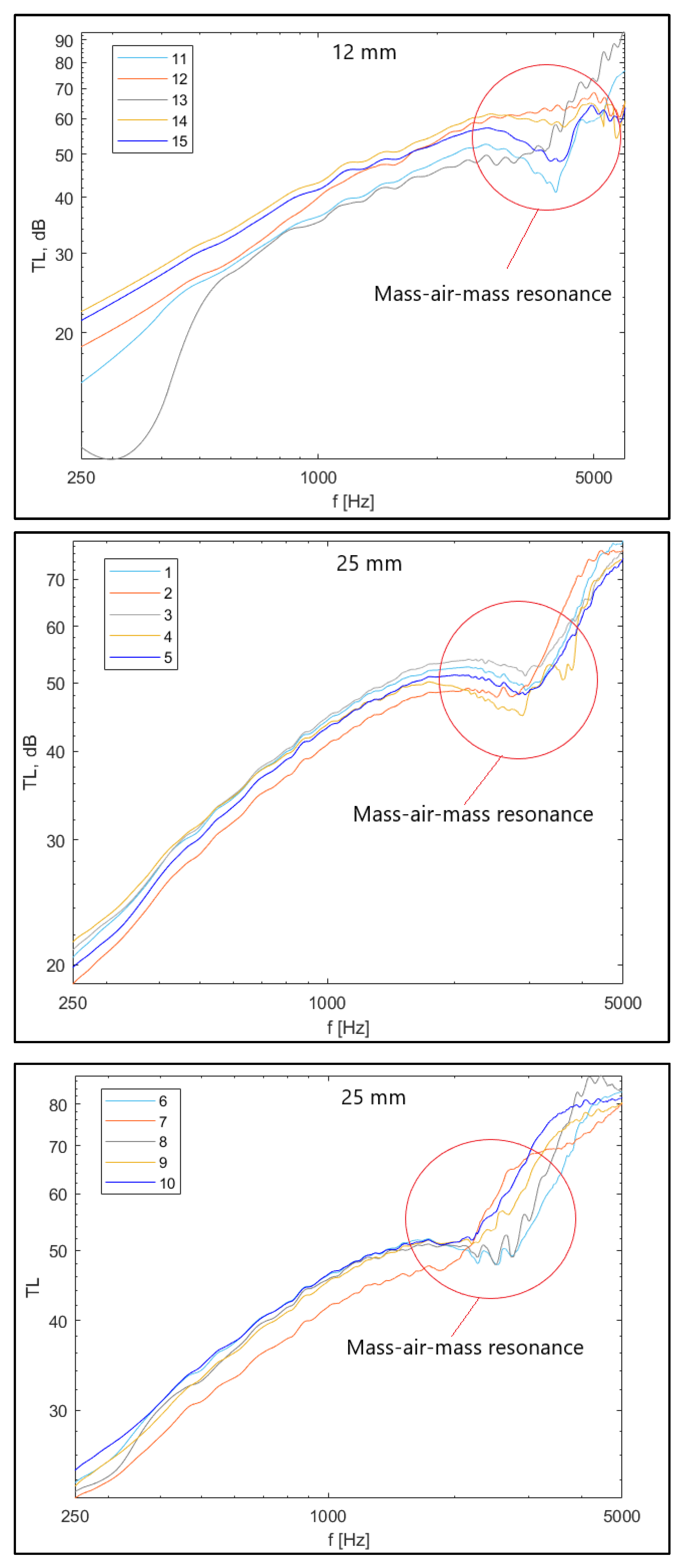
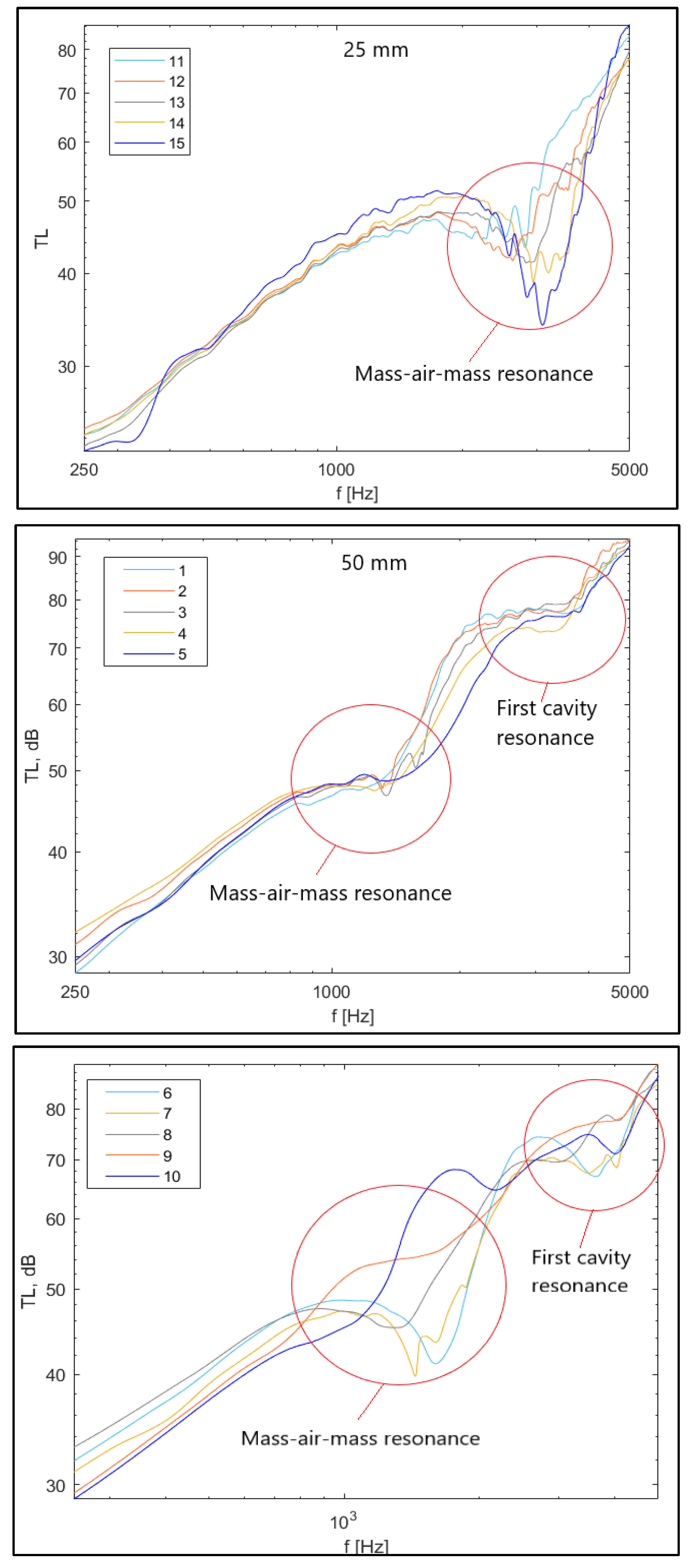
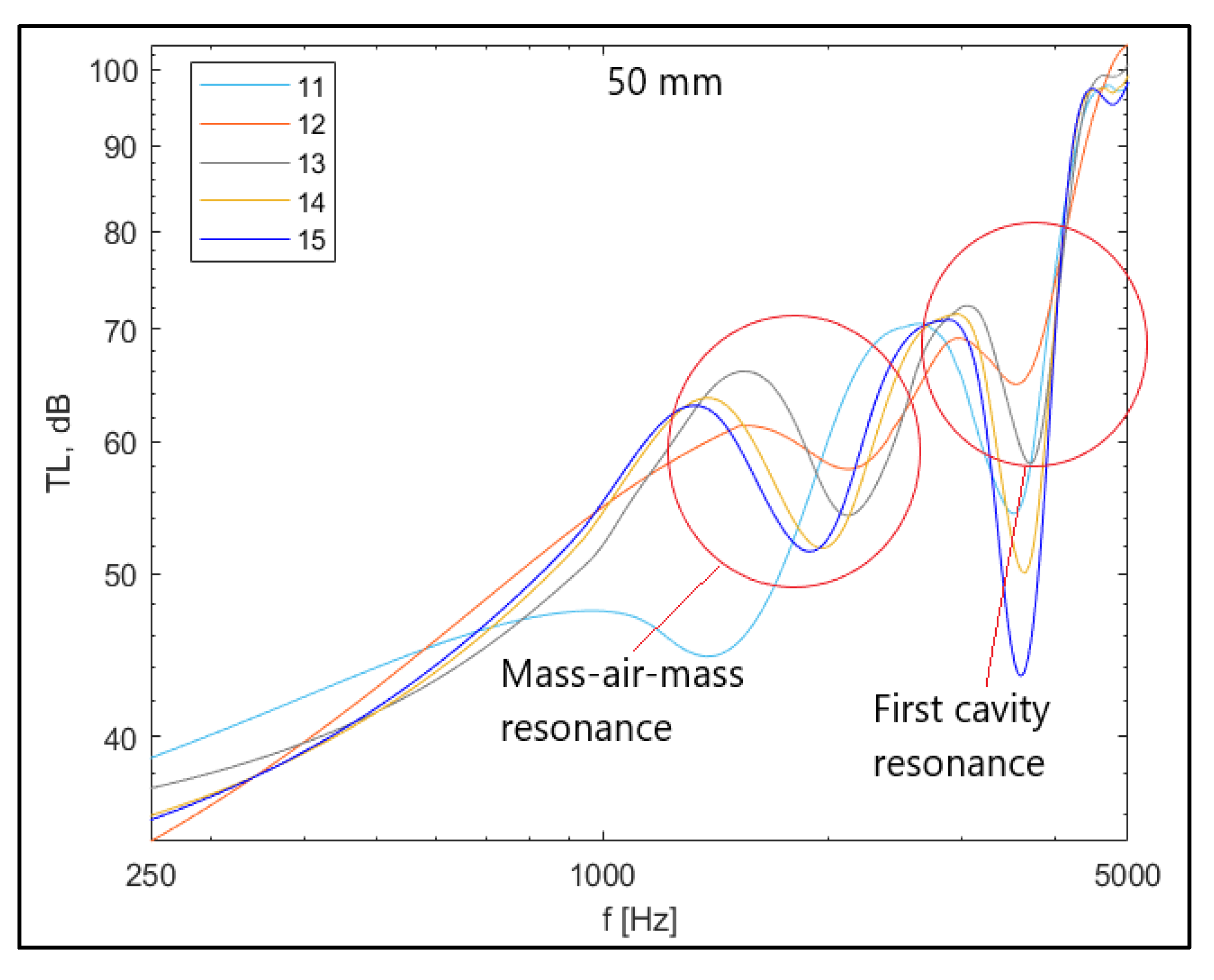
3.2. Experimental Results of Transmission Loss in an Impedace Tube
4. Discussion
5. Conclusions
- After the TMM analysis, it was found that by increasing the thickness of the rubber sample, it was possible to control the mass-air-mass resonance of the structure. In prediction with 12 mm samples, the mass-air-mass resonance was determined at 4000 Hz, in 25 mm at 2500–3000 Hz, while with 50 mm thick samples, the mass-air-mass resonance was at 2000 Hz, but also occurred additional air cavity resonance, which was set at 3500–4000 Hz. When comparing the TMM results with the experimental results, it could be stated that in the experimental studies, the resonant frequencies were set at slightly lower frequencies, but the trends remained the same.
- According to experimental results of transmission loss, constructions with 50 mm thick samples had on average 3 dB better results than the structures with 25 mm samples and 5dB better than the structures with 12 mm thick rubber samples.
- According to experimental studies, it was found that higher density plasterboards (GKFI) increased the overall transmission loss value of the structure by 5 dB. The same trends were determined by the TMM method.
- Constructions with denser rubber samples (10,11) generally showed better results, but very clear trends were not expressed. In this case, it depended more on the dynamic properties of the rubber sample, which were not determined in the scope of this study.
Author Contributions
Funding
Institutional Review Board Statement
Informed Consent Statement
Data Availability Statement
Acknowledgments
Conflicts of Interest
References
- Khan, S.U.; Ahmed, A.; Ali, S.; Ayub, A.; Shuja, A.; Shahid, M.A. Use of scrapped rubber tires for sustainable construction of manhole covers. J. Renew. Mater. 2021, 9, 1013–1029. [Google Scholar] [CrossRef]
- Chen, Z.; Liang, Y.; Lin, Y.; Cai, J. Recycling of waste tire rubber as aggregate in impact-resistant engineered cementitious composites. Constr. Build. Mater. 2022, 359, 129477. [Google Scholar] [CrossRef]
- Wiśniewska, P.; Wang, S.; Formela, K. Waste tire rubber devulcanization technologies: State-of-the-art, limitations and future perspectives. Waste Manag. 2022, 150, 174–184. [Google Scholar] [CrossRef] [PubMed]
- Formela, K. Waste tire rubber-based materials: Processing, performance properties and development strategies. Adv. Ind. Eng. Polym. Res. 2022, 5, 234–247. [Google Scholar] [CrossRef]
- Najim, K.B.; Hall, M.R. Mechanical and dynamic properties of self-compacting crumb rubber modified concrete. Constr. Build. Mater. 2012. [Google Scholar] [CrossRef]
- Kovler, K.; Roussel, N. Properties of fresh and hardened concrete. Cem. Concr. Res. 2011. [Google Scholar] [CrossRef]
- Uyguno, T.; Topçu, I.B. The role of scrap rubber particles on the drying shrinkage and mechanical properties of self-consolidating mortars. Constr. Build. Mater. 2010. [Google Scholar] [CrossRef]
- Medina, N.F.; Garcia, R.; Hajirasouliha, I.; Pilakoutas, K.; Guadagnini, M.; Raffoul, S. Composites with recycled rubber aggregates: Properties and opportunities in construction. Construction and Building Materials 2018. [Google Scholar] [CrossRef]
- Gerges, N.N.; Issa, C.A.; Fawaz, S.A. Rubber concrete: Mechanical and dynamical properties. Case Stud. Constr. Mater. 2018. [Google Scholar] [CrossRef]
- Asaro, L.; Gratton, M.; Seghar, S.; Aït Hocine, N. Recycling of rubber wastes by devulcanization. Resour. Conserv. Recycl. 2018, 133, 250–262. [Google Scholar] [CrossRef]
- Karger-Kocsis, J.; Mészáros, L.; Bárány, T. Ground tyre rubber (GTR) in thermoplastics, thermosets, and rubbers. Journal of Materials Science 2013, 48, 1–38. [Google Scholar] [CrossRef]
- Costamagna, M.; et al. Environmental assessment of rubber recycling through an innovative thermo-mechanical devulcanization process using a co-rotating twin-screw extruder. J. Clean. Prod. 2022, 348, 131352. [Google Scholar] [CrossRef]
- Meysami, M. A Study of Scrap Rubber Devulcanization and Incorporation of Devulcanized Rubber into Virgin Rubber Compounds. 2012, p. 216. Available online: https://uwspace.uwaterloo.ca/handle/10012/6609.
- Wang, W.; et al. Mechano-chemical rubber reclamation using aminolysis products of waste flexible polyurethane foams as the devulcanizing agent. J. Clean. Prod. 2023, 384, 135421. [Google Scholar] [CrossRef]
- Wang, Z.; Pan, C.; Hu, Y.; Zeng, D.; Huang, M.; Jiang, Y. High-quality ground tire rubber production from scrap tires by using supercritical carbon dioxide jet pulverization assisted with diphenyl disulfide. Powder Technol. 2022, 398. [Google Scholar] [CrossRef]
- Saputra, R.; Walvekar, R.; Khalid, M.; Mubarak, N.M.; Sillanpää, M. Current progress in waste tire rubber devulcanization. Chemosphere 2021, 265. [Google Scholar] [CrossRef]
- Isayev, A.I.; Liang, T.; Lewis, T.M. Effect of particle size on ultrasonic devulcanization of tire rubber in twin-screw extruder. Rubber Chem. Technol. 2014, 87, 86–102. [Google Scholar] [CrossRef]
- Mangili, I.; Lasagni, M.; Huang, K.; Isayev, A.I. Modeling and optimization of ultrasonic devulcanization using the response surface methodology based on central composite face-centered design. Chemom. Intell. Lab. Syst. 2015, 144, 1–10. [Google Scholar] [CrossRef]
- Vahdatbin, M.; Jamshidi, M. Using chemical agent in microwave assisted devulcanization of NR/SBR blends: An effective recycling method. Resour. Conserv. Recycl. 2022, 179, 106045. [Google Scholar] [CrossRef]
- Tatangelo, V.; et al. Biological devulcanization of ground natural rubber by Gordonia desulfuricans DSM 44462T strain. Appl. Microbiol. Biotechnol. 2016, 100, 8931–8942. [Google Scholar] [CrossRef]
- Gumede, J.I.; Hlangothi, B.G.; Woolard, C.D.; Hlangothi, S.P. Organic chemical devulcanization of rubber vulcanizates in supercritical carbon dioxide and associated less eco-unfriendly approaches: A review. Waste Manag. Res. 2022, 40, 490–503. [Google Scholar] [CrossRef]
- Wang, Z.; Zeng, D. Preparation of devulcanized ground tire rubber with supercritical carbon dioxide jet pulverization. Mater. Lett. 2021, 282, 128878. [Google Scholar] [CrossRef]
- Xu, X.; Wang, H.; Sun, Y.; Han, J.; Huang, R. Sound absorbing properties of perforated composite panels of recycled rubber, fiberboard sawdust, and high density polyethylene. J. Clean. Prod. 2018, 187, 215–221. [Google Scholar] [CrossRef]
- Maderuelo-Sanz, R.; Nadal-Gisbert, A.V.; Crespo-Amorós, J.E.; Parres-García, F. A novel sound absorber with recycled fibers coming from end of life tires (ELTs). Appl. Acoust. 2012, 73, 402–408. [Google Scholar] [CrossRef]
- Juliá, E.; Segura, J.; Nadal, A.; Gadea, J.M.; Crespo, J.E. Study of Sound Absorption Properties of Multilayer Panels Made From Ground Tyre Rubbers. Fascicle of Management and Technological Engineering 2013, 1, 147–150. [Google Scholar] [CrossRef]
- Bujoreanu, C.; Nedeff, F.; Benchea, M.; Agop, M. Experimental and theoretical considerations on sound absorption performance of waste materials including the effect of backing plates. Appl. Acoust. 2017, 119, 88–93. [Google Scholar] [CrossRef]
- Lee, C.M.; Xu, Y. A modified transfer matrix method for prediction of transmission loss of multilayer acoustic materials. J. Sound Vib. 2009, 326, 290–301. [Google Scholar] [CrossRef]
- Theocharis, G.; Richoux, O.; García, V.R.; Merkel, A.; Tournat, V. Limits of slow sound propagation and transparency in lossy, locally resonant periodic structures. New J. Phys. 2014, 16. [Google Scholar] [CrossRef]
- Dell, A.; Krynkin, A.; Horoshenkov, K.V. The use of the transfer matrix method to predict the effective fluid properties of acoustical systems. Appl. Acoust. 2021, 182, 108259. [Google Scholar] [CrossRef]
- Salissou, Y.; Panneton, R. A general wave decomposition formula for the measurement of normal incidence sound transmission loss in impedance tube. J. Acoust. Soc. Am. 2009, 125, 2083–2090. [Google Scholar] [CrossRef]
- Tao, Z.; Seybert, A.F. A Review of Current Techniques for Measuring Muffler Transmission Loss. 2010. [Google Scholar] [CrossRef]
- Lung, T.Y.; Doige, A.G. A time-averaging transient testing method for acoustic properties of piping systems and mufflers with flow. J. Acoust. Soc. Am. 2005. [Google Scholar] [CrossRef]
- Munjal, M.L.; Doige, A.G. Theory of a two source-location method for direct experimental evaluation of the four-pole parameters of an aeroacoustic element. J. Sound Vib. 1990. [Google Scholar] [CrossRef]
- Kim, H.S.; Ma, P.S.; Kim, B.K.; Lee, S.H.; Seo, Y.H. Sound transmission loss of multi-layered elastic micro-perforated plates in an impedance tube. Appl. Acoust. 2020, 166, 107348. [Google Scholar] [CrossRef]
- Long, M. Sound Transmission Loss. In Architectural Acoustics; 2014. [Google Scholar]
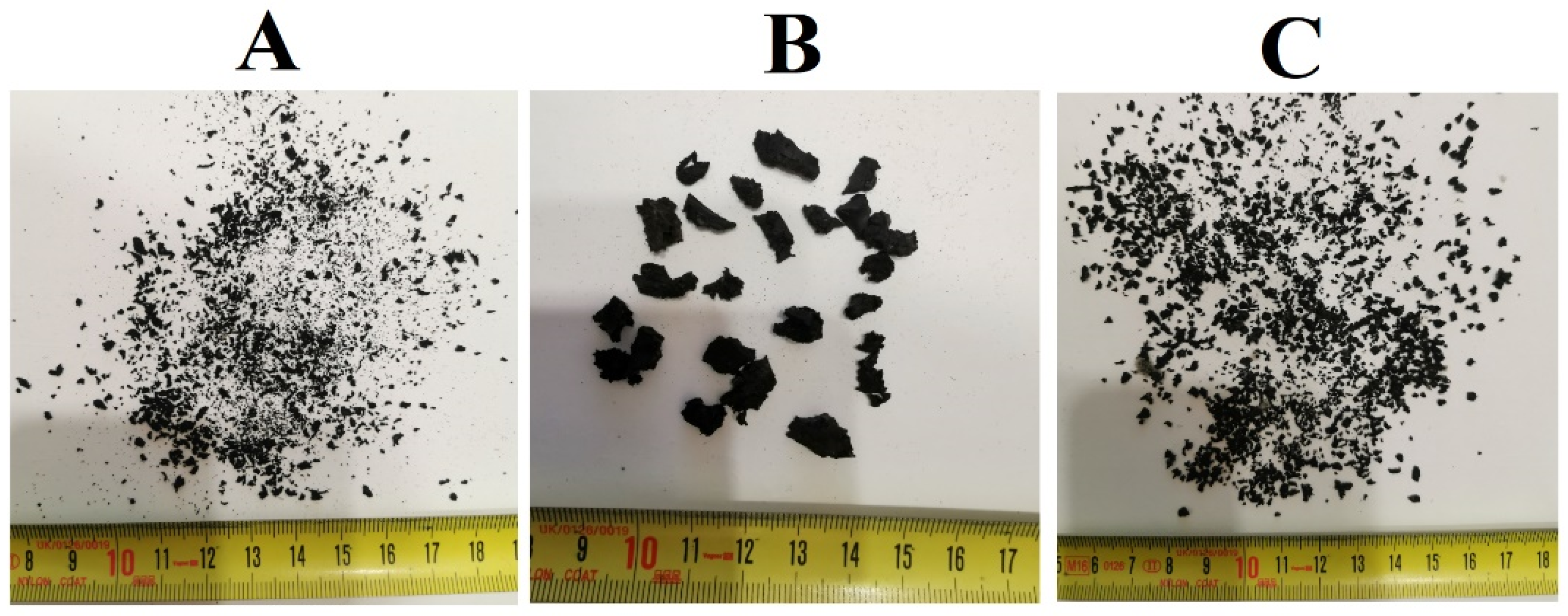
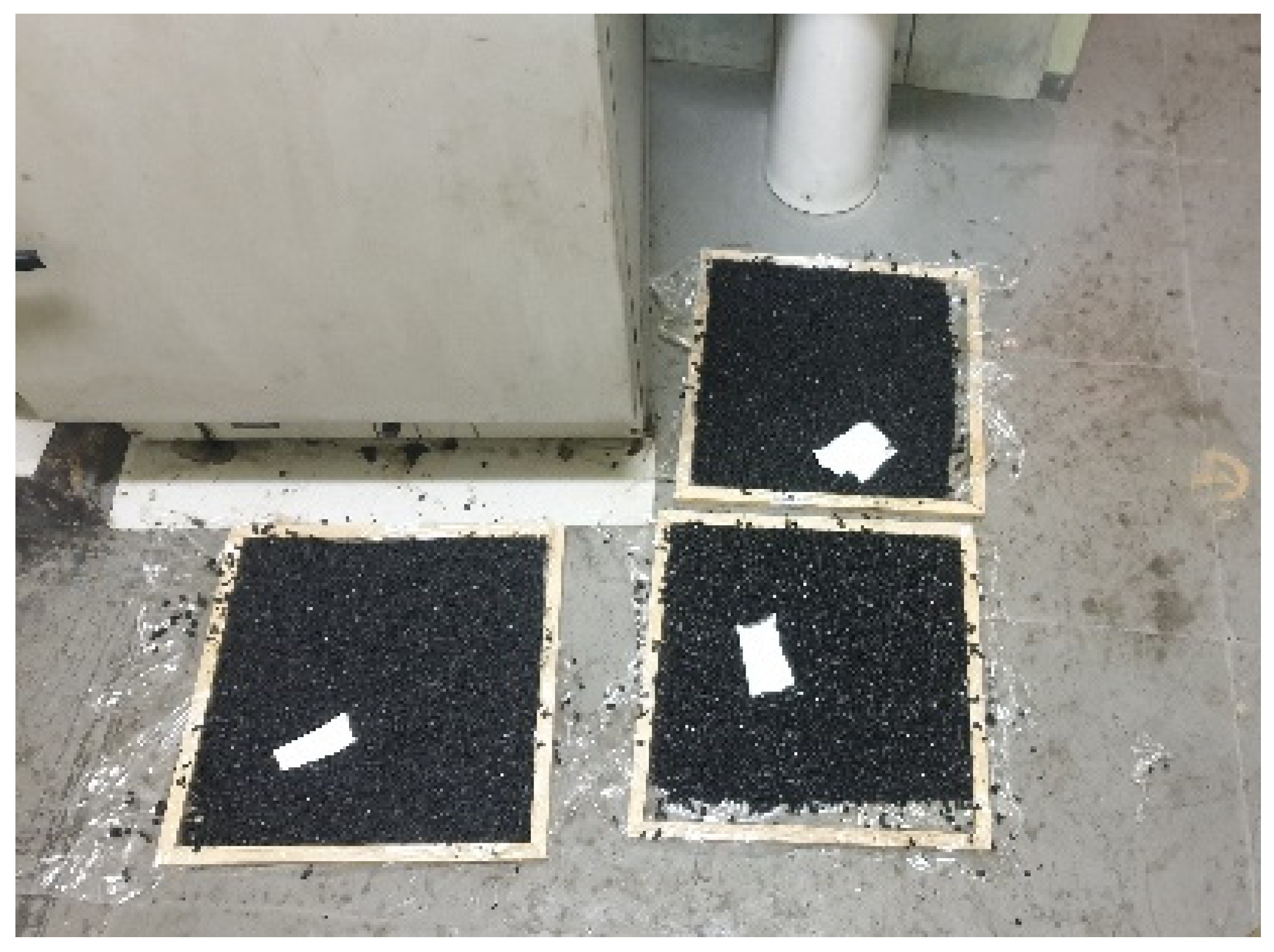

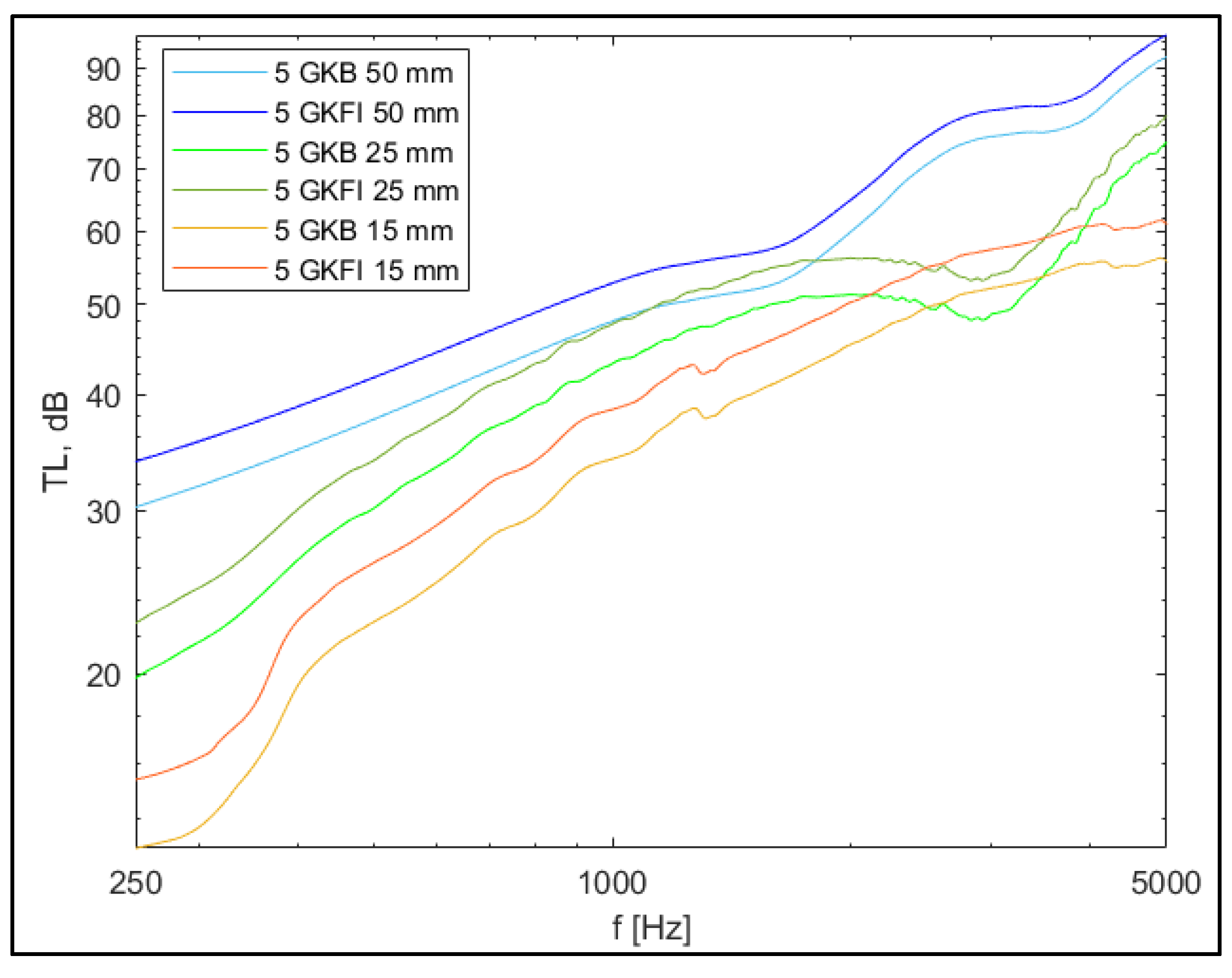
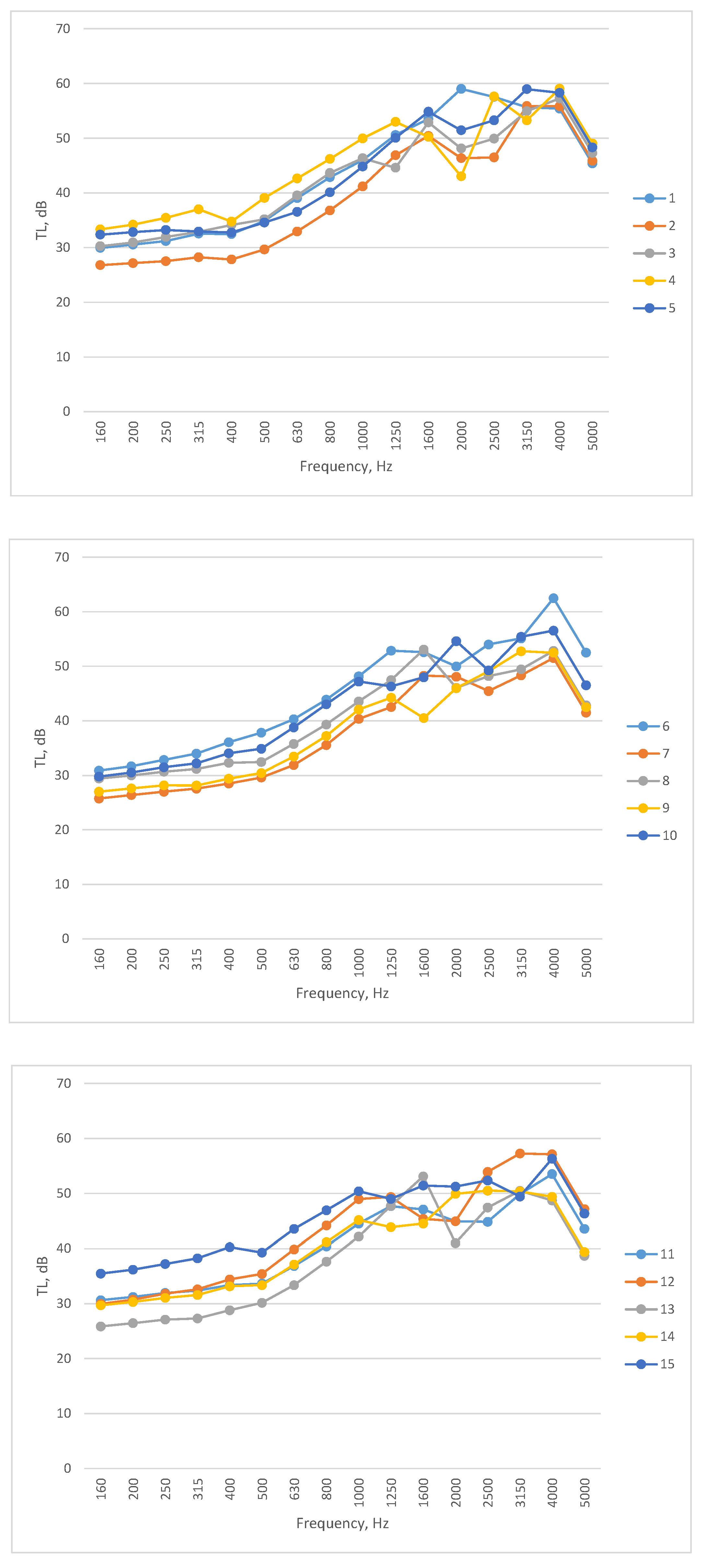
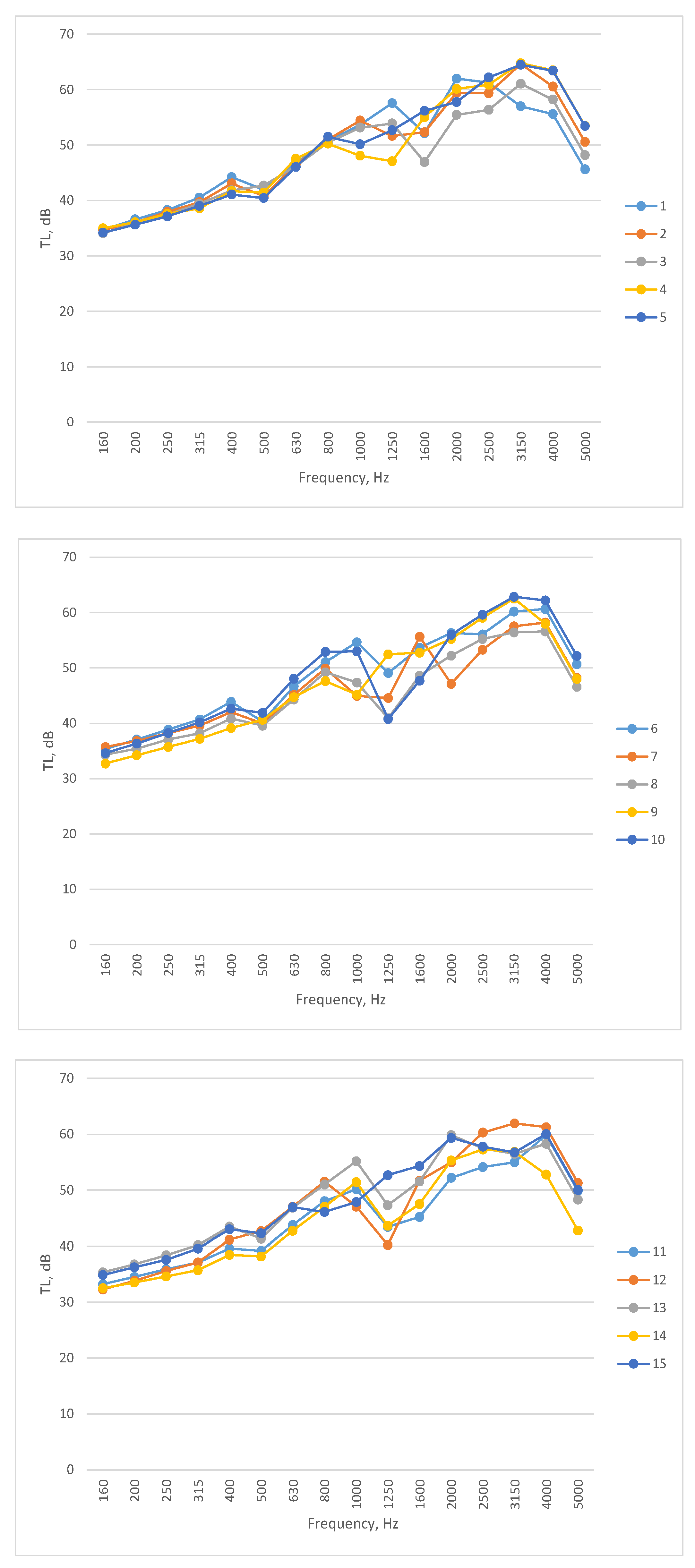
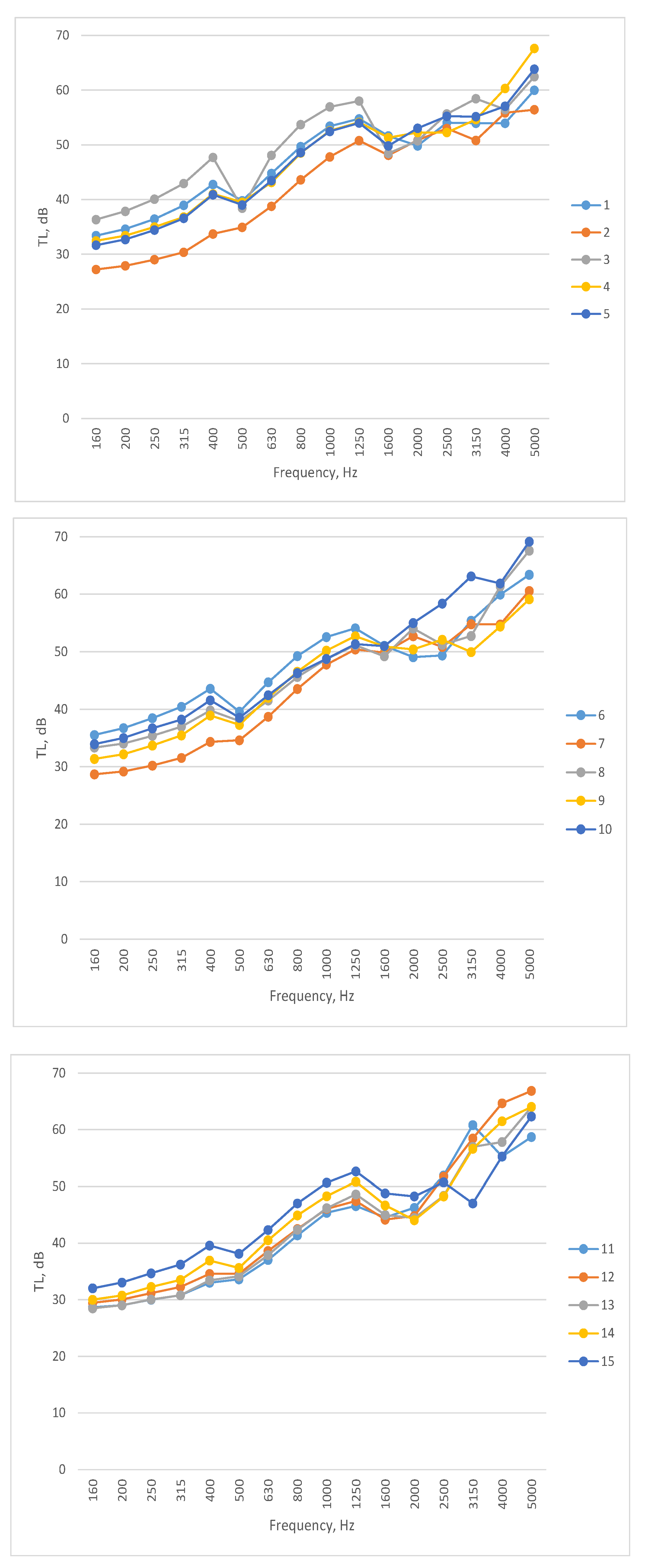
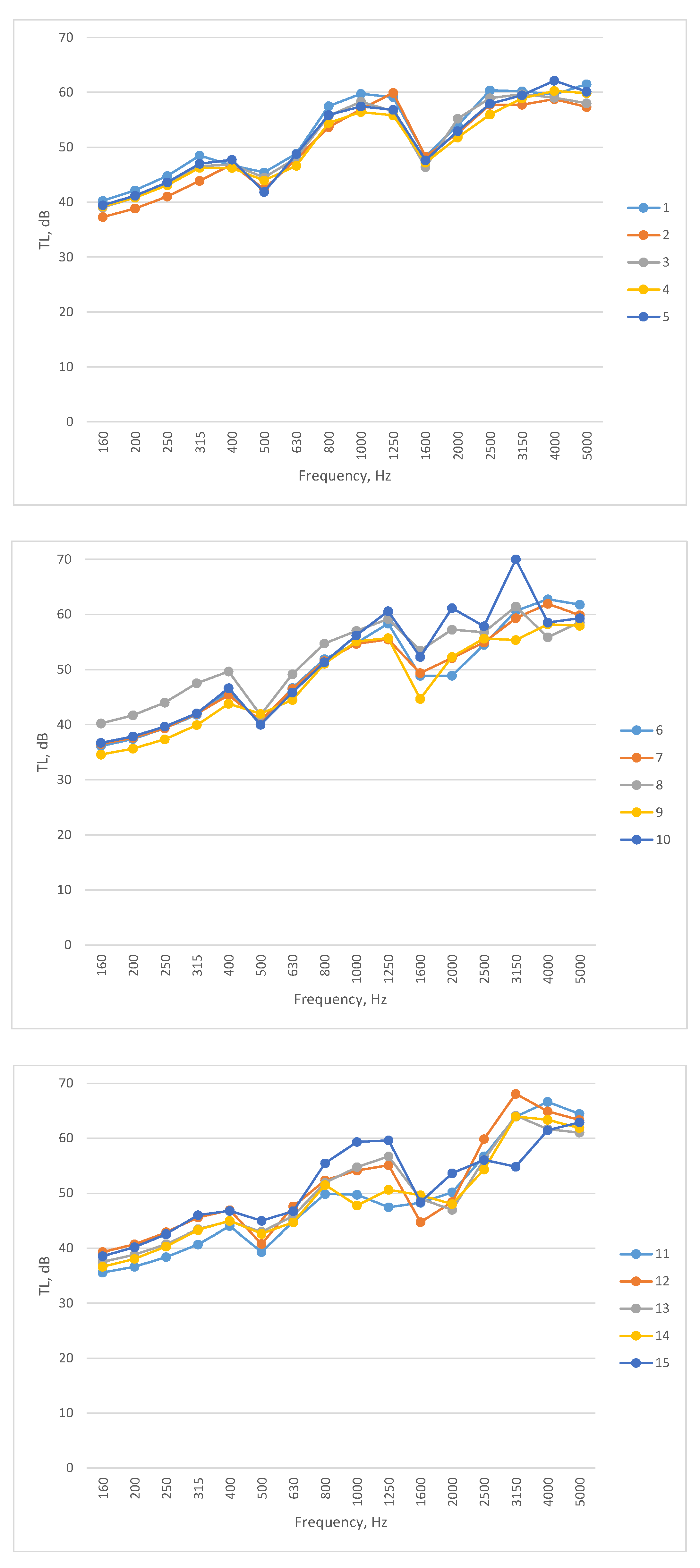

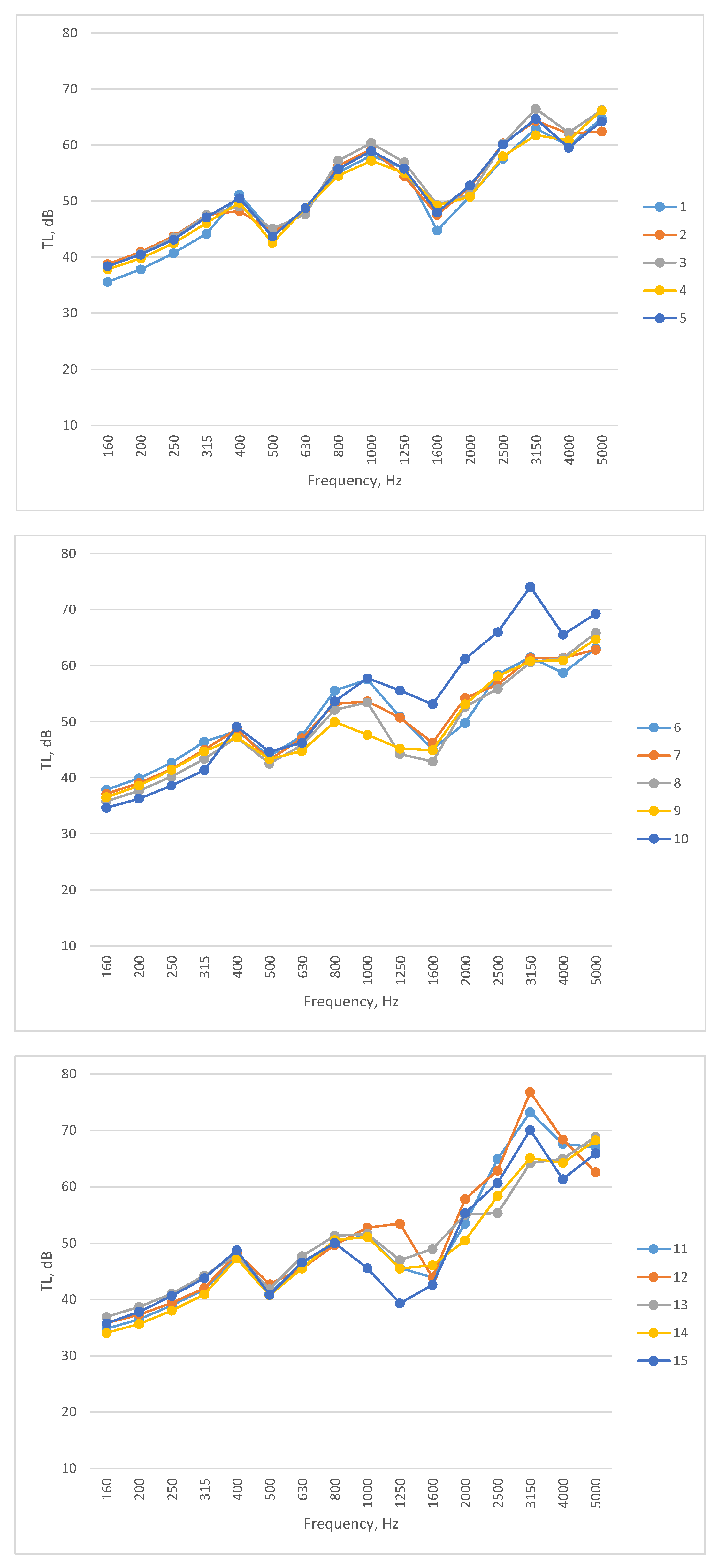
| Sample No. | 1 | 2 | 3 | 4 | 5 | 6 | 7 | 8 | 9 | 10 | 11 | 12 | 13 | 14 | 15 |
| Large fraction, % |
0 | 0 | 0 | 0 | 0 | 25 | 25 | 25 | 25 | 50 | 50 | 50 | 75 | 75 | 100 |
| Small fraction, % | 0 | 25 | 50 | 75 | 100 | 25 | 50 | 75 | 0 | 25 | 50 | 0 | 25 | 0 | 0 |
| Devulcanized fraction, % | 100 | 75 | 50 | 25 | 0 | 50 | 25 | 0 | 75 | 25 | 0 | 50 | 0 | 25 | 0 |
| Density, kg/m3 | 697.4 | 661.7 | 706.8 | 728.9 | 697.6 | 721.9 | 797.7 | 762.1 | 737.4 | 776.8 | 776.1 | 691.8 | 783.6 | 675.9 | 731.4 |
| Sample No. | Construction | |||||
|---|---|---|---|---|---|---|
| 12 mm GKB |
25 mm GKB |
50 mm GKB |
12 mm GKFI |
25 mm GKFI |
50 mm GKFI |
|
| Equivalent value of transmission loss, dB | ||||||
| 1 | 64.1 | 64.3 | 64.5 | 67.6 | 68.7 | 69.2 |
| 2 | 61.2 | 61.9 | 65.6 | 68.5 | 66.6 | 69.6 |
| 3 | 62.2 | 67.0 | 67.1 | 66.5 | 67.2 | 71.5 |
| 4 | 64.5 | 69.1 | 66.8 | 69.7 | 66.7 | 69.6 |
| 5 | 64.9 | 66.5 | 65.1 | 69.5 | 67.9 | 69.8 |
| 6 | 65.1 | 66.5 | 68.0 | 66.9 | 68.0 | 68.0 |
| 7 | 60.2 | 63.7 | 66.1 | 64.0 | 66.9 | 67.9 |
| 8 | 60.3 | 69.1 | 63.0 | 64.0 | 67.5 | 68.8 |
| 9 | 58.3 | 62.9 | 66.6 | 66.6 | 64.9 | 68.2 |
| 10 | 62.3 | 71.2 | 70.5 | 67.9 | 71.9 | 76.5 |
| 11 | 60.2 | 64.2 | 68.7 | 63.7 | 70.4 | 75.5 |
| 12 | 63.1 | 69.5 | 72.5 | 67.2 | 71.4 | 77.8 |
| 13 | 60.0 | 65.9 | 69.1 | 66.1 | 68.4 | 71.7 |
| 14 | 58.7 | 66.8 | 69.0 | 63.4 | 68.5 | 71.4 |
| 15 | 62.8 | 64.4 | 68.0 | 65.8 | 68.3 | 72.4 |
| Arithmetical average of transmission loss, dB | 61.9 | 66.2 | 67.4 | 66.5 | 68.2 | 71.2 |
Disclaimer/Publisher’s Note: The statements, opinions and data contained in all publications are solely those of the individual author(s) and contributor(s) and not of MDPI and/or the editor(s). MDPI and/or the editor(s) disclaim responsibility for any injury to people or property resulting from any ideas, methods, instructions or products referred to in the content. |
© 2023 by the authors. Licensee MDPI, Basel, Switzerland. This article is an open access article distributed under the terms and conditions of the Creative Commons Attribution (CC BY) license (http://creativecommons.org/licenses/by/4.0/).





